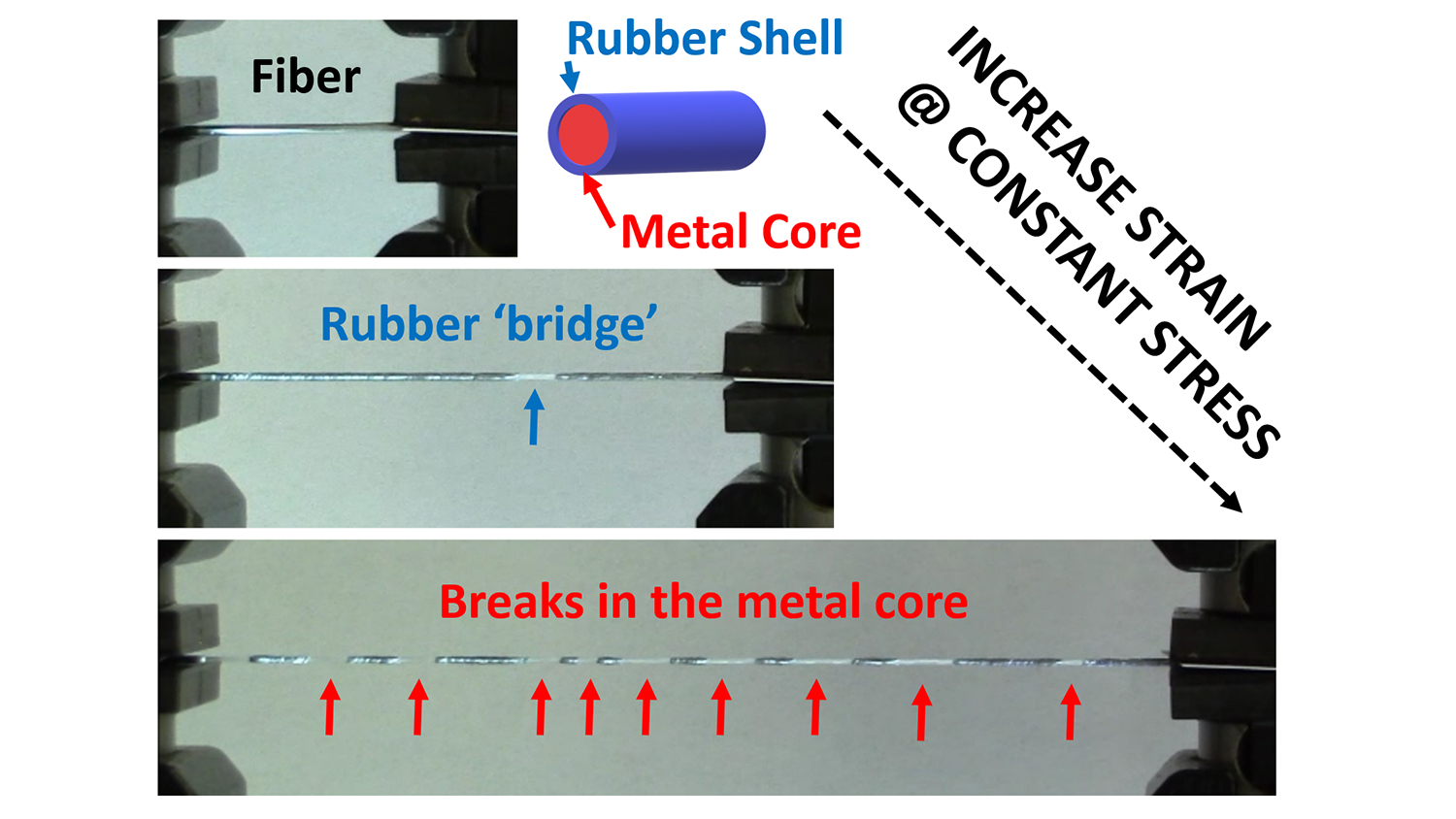Researchers Engineer a Tougher Fiber

For Immediate Release
North Carolina State University researchers have developed a fiber that combines the elasticity of rubber with the strength of a metal, resulting in a tougher material that could be incorporated into soft robotics, packaging materials or next-generation textiles.
“A good way of explaining the material is to think of rubber bands and metal wires,” says Michael Dickey, corresponding author of a paper on the work and Alcoa Professor of Chemical and Biomolecular Engineering at NC State.
“A rubber band can stretch very far, but it doesn’t take much force to stretch it,” Dickey says. “A metal wire requires a lot of force to stretch it, but it can’t take much strain – it breaks before you can stretch it very far. Our fibers have the best of both worlds.”
The researchers created fibers consisting of a gallium metal core surrounded by an elastic polymer sheath. When placed under stress, the fiber has the strength of the metal core. But when the metal breaks, the fiber doesn’t fail – the polymer sheath absorbs the strain between the breaks in the metal and transfers the stress back to the metal core. This response is similar to the way human tissue holds together broken bones. A video about the fiber can be found here: https://youtu.be/DinKijagcQA
“Every time the metal core breaks it dissipates energy, allowing the fiber to continue to absorb energy as it elongates,” Dickey says. “Instead of snapping in two when stretched, it can stretch up to seven times its original length before failure, while causing many additional breaks in the wire along the way.
“To think of it another way, the fiber won’t snap and drop a heavy weight. Instead, by releasing energy repeatedly through internal breaks, the fiber lowers the weight slowly and steadily.”
In materials, toughness is a material’s ability to absorb energy and deform without breaking. You can think of it as the amount of force a material can absorb as it is deformed over a distance. The new fiber is far tougher than either the metal wire or the polymer sheath on its own.
“There’s a lot of interest in engineering materials to mimic the toughness of skin – and we have developed a fiber that has surpassed the toughness of skin yet is still elastic like skin,” Dickey says.
In addition, the gallium core is conductive – though it loses its conductivity when the internal core breaks. The fibers can also be reused by melting the metal cores back together.
“We used gallium for this proof of concept work, but the fibers could be tuned to alter their mechanical properties, or to retain functionality at higher temperatures, by using different materials in the core and shell,” Dickey says.
“This is only a proof of concept, but it holds a lot of potential. We are interested to see how these fibers could be used in soft robotics or when woven into textiles for various applications.”
The paper, “Toughening stretchable fibers via serial fracturing of a metallic core,” is published in the open access journal Science Advances. First author is Christopher Cooper, a former undergraduate at NC State. The paper was co-authored by Ishan Joshipura, Dishit Parekh and Russell Mailen, former Ph.D. students at NC State; Justin Norkett, a current Ph.D. student at NC State; Victoria Miller, an assistant professor of materials science and engineering at NC State; and Jan Genzer, S. Frank & Doris Culberson Distinguished Professor of Chemical and Biomolecular Engineering at NC State.
The work was done with support from NC State’s National Science Foundation-funded Advanced Self-Powered Systems of Integrated Sensors and Technologies (ASSIST) Center. The mission of the ASSIST Center is to create self-powered wearables capable of long-term multi-modal sensing without having to replace or charge the batteries.
-shipman-
Note to Editors: The study abstract follows.
“Toughening stretchable fibers via serial fracturing of a metallic core”
Authors: Christopher B. Cooper, Ishan D. Joshipura, Dishit P. Parekh, Justin Norkett, Russell Mailen, Victoria M. Miller, Jan Genzer and Michael D. Dickey, North Carolina State University
Published: Feb. 22, Science Advances
DOI: 10.1126/sciadv.aat4600
Abstract: Tough, biological materials (e.g., collagen or titin) protect tissues from irreversible damage caused by external loads. Mimicking these protective properties is important in packaging and in emerging applications such as durable electronic skins and soft robotics. This paper reports the formation of tough, metamaterial-like core-shell fibers that maintain stress at the fracture strength of a metal throughout the strain of an elastomer. The shell experiences localized strain enhancements that cause the higher modulus core to fracture repeatedly, increasing the energy dissipated during extension. Normally, fractures are catastrophic. However, in this architecture, the fractures are localized to the core. In addition to dissipating energy, the metallic core provides electrical conductivity and enables repair of the fractured core for repeated use. The fibers are 2.5 times tougher than titin and hold more than 15,000 times their own weight for a period 100 times longer than a hollow elastomeric fiber.
- Categories:


